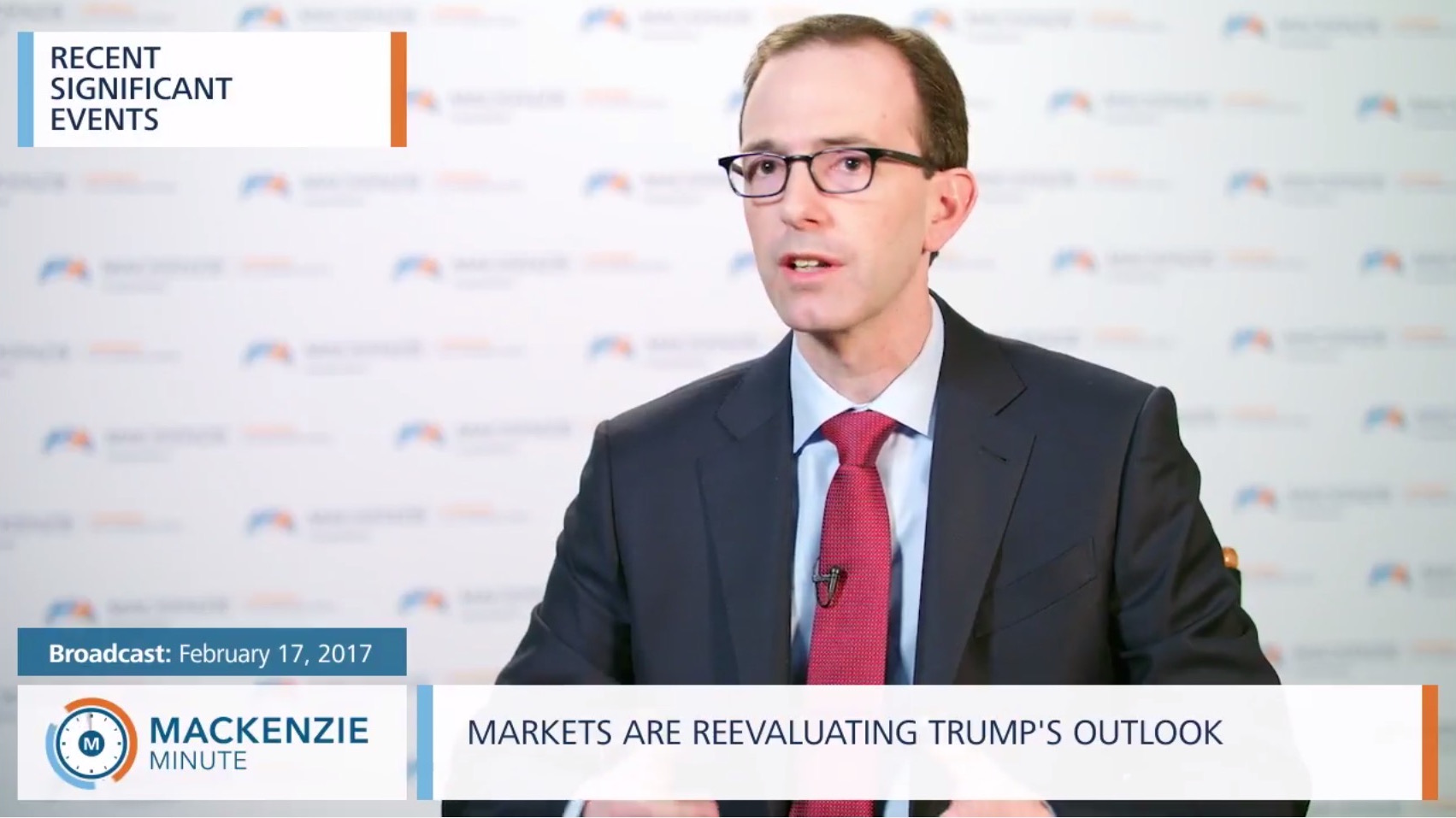How diversified credit portfolios can help defend against rising interest rates
by Rob Waldner, IFI Chief Strategist; Joseph Portera, CIO, High Yield and Multi-Sector Credit; and Mike Hyman, CIO Global Investment Grade and Emerging Markets, Invesco US
In December, the US Federal Reserve (Fed) raised interest rates, as predicted, and raised expectations for more increases in 2017. At Invesco Fixed Income, we believe one of the best ways to handle a rising interest rate environment is to have a portfolio diversified across different credit-related asset classes. Below, we answer some frequently asked questions about how we approach diversification.
What is IFI’s overall outlook for 2017?
Rob Waldner: We believe we are entering a new regime where growth and inflation, rather than just the actions of central banks, drive markets. We believe that President Donald Trump’s policies will be, on balance, supportive for US growth, although much uncertainty remains around policy specifics. We expect steady, although moderate, growth in Europe and China. While we are mindful of political risk globally, especially in Europe where the election calendar is heavy, we think that stronger global growth and a little higher inflation will likely determine much of the markets’ performance in 2017.
What are your thoughts on rising interest rates as you determine your asset allocation decisions?
Rob Waldner: Traditionally, we think about government bonds as being a “risk-free” asset class — in other words, an asset class whose return is considered to be certain. But clearly in a world where government bond yields are very low and are expected to rise, there is little in the way of coupon income to offset downward price movement.
So for us, the idea is to invest in credit asset classes that we believe can benefit from a positive growth environment and are less correlated to government bonds. These can include investment grade bonds, high yield bonds, bank loans, emerging markets sovereign bonds and corporate bonds, as well as structured securities and even municipal bonds. In our view, a portfolio that is broadly diversified across credit sectors should be able to perform relatively well in an environment in which growth is solid.
We believe the economy is poised to perform relatively well. The thing that we need to be concerned about is the status of global financial conditions, and whether tightening financial conditions could cause volatility in credit markets in 2017. Concerns over financial conditions could arise if we see a more-aggressive-than-expected Fed, or a sharp rise in bond yields or the US dollar.
Can you describe your multi-sector approach for navigating a rising interest rate environment?
Joe Portera: In our diversified credit strategies, we seek to take advantage of different credit sectors — each one brings something a little different to the table. In the current environment of rising interest rates underpinned by growth and moderate inflation, we favor leveraged credit, such as high yield bonds and bank loans. The floating rate nature of bank loans can be especially defensive since interest rates on bank loans adjust on a regular basis to keep pace with rising short-term rates. Given these characteristics, we have increased our exposure to loans in the last couple of months.
As active investment managers, we can take advantage of bond futures to hedge portfolios and interest rate swaps to convert fixed rate holdings into floating rate holdings. If the price of the swap is attractive, we can take advantage of rising interest rates even when holding an underlying portfolio of fixed rate securities.
We also include emerging market sovereign and corporate debt as well as investment grade corporates in our diversified credit strategies. While we have de-emphasized investment grade relative to other sectors recently, given our favorable growth outlook, our analyst team can still find opportunities among these corporate bonds. Investment grade bonds bring quality to the mix in our portfolios and, despite conventional wisdom, may present select opportunities despite the rising rate environment.
What are some of your strategies for dealing with rising US interest rates within investment grade bonds, especially when valuations are so stretched?
Mike Hyman: When the bond market begins to anticipate a Fed tightening cycle, investors often react by gravitating toward the short end of the yield curve — i.e., toward shorter-maturity bonds. The general thinking is that longer-duration bonds should be avoided to potentially dodge price declines when interest rates rise. However, the shorter-maturity bonds have typically been the most vulnerable when the Fed raises rates.
That’s why in a rising rate environment, we look for opportunities in longer-term maturities in the investment grade sector to try to take advantage of attractive yields and to potentially defend against the greater interest rate increases that may occur at the shorter end.
In many of our investment grade portfolios, we are also permitted to take exposure to diversifying credit sectors such as high yield and emerging market debt. High yield can be a good diversifier for investment grade credit in a solid growth environment. Due to the higher spread of these bonds, they have the ability to absorb increasing Treasury rate movements with little change in price.
How do rising US rates affect emerging market bonds?
Mike Hyman: Rising US interest rates are generally a headwind for emerging market (EM) fixed income performance. However, emerging markets is a very diverse asset class. For example, emerging markets comprise both US dollar- and non-US dollar-denominated assets. The net exposure of EM countries to US dollar funding has declined as they have built up healthy cushions of foreign exchange reserves. Although US dollar-denominated debt, particularly corporate debt, has grown significantly in recent years, foreign exchange reserves have grown even faster.1 This may provide a buffer for most EM countries when navigating through a period of potentially higher US interest rates, particularly if funding conditions deteriorate.
As a diverse asset class, we believe EM offers enough different levers to pull to help successfully navigate the increasingly complex global financial landscape in the period ahead. Within EM, we would look for specific opportunities that stand to benefit broadly from modest global growth and more stable commodity prices.
Learn more about our approach
Invesco Fixed Income’s approach to diversified credit portfolios can be accessed through several retail and institutional products, including Invesco Core Plus Bond Fund and Invesco Strategic Real Return Fund.
1 Sources: World Bank, International Monetary Fund, Invesco. Data from March 31, 2000, to Dec. 31, 2016.
*****
Authors
Robert B. Waldner, Jr., CFA
Chief Strategist and Head of Multi-Sector
Rob Waldner is Chief Strategist and Head of Multi-Sector for Invesco Fixed Income (IFI). Mr. Waldner has overall management responsibility for the IFI public credit asset class teams and the Multi-Sector team. In this role, he is responsible for oversight of the portfolio construction process for IFI’s public security portfolios. Mr. Waldner chairs the IFI Investment Strategy team and is responsible for oversight of the overall IFI investment process. He joined Invesco in 2013.
Prior to joining Invesco, Mr. Waldner worked with Franklin Templeton for 17 years. At Franklin Templeton, he was a senior strategist and senior portfolio manager. He was the lead manager for Franklin absolute return strategies, and a member of the Fixed Income Policy Committee. Mr. Waldner was instrumental in the launch of a number of new strategies on the Franklin Templeton fixed income platform. Previously, Mr. Waldner was a member of the Macro team at Omega Advisors and a portfolio manager with Glaxo (Bermuda) Ltd. He entered the industry in 1986.
Mr. Waldner earned a BSE degree in civil engineering from Princeton University, graduating magna cum laude in 1986. He is a CFA charterholder.
Joseph Portera
CIO, High Yield and Multi Sector Credit
Joseph Portera serves as Chief Investment Officer, High Yield and Multi Sector Credit with Invesco Fixed Income. In this role, he will singularly focus on high yield business and multi sector credit with a specific focus on overall risk positioning, driving performance, and portfolio reviews. He is a member of the Office of the Chief Investment Officer.
Prior to joining Invesco in 2012, Mr. Portera spent three years at Hartford Investment Management as a managing director and lead portfolio manager on several funds, including core plus and emerging markets products, and was a senior member of the Global Fixed Income investment platform at Mackay Shields. He entered the industry in 1981.
Mr. Portera earned a BA degree in Soviet studies and an MA degree in international political economy and development from Fordham University.
Michael D. Hyman
CIO, Global Investment Grade & Emerging Markets
Michael Hyman is Chief Investment Officer, Global Investment Grade & Emerging Markets for Invesco Fixed Income. He joined Invesco in 2013.
Previously, Mr. Hyman was with ING Investment Management and ING Institutional Markets for 12 years. At ING, he was the head of investment grade corporate credit, responsible for investment grade corporate credit as well as collaterized loan obligation and synthetic collateralized debt obligation investment portfolios. Prior to joining ING, Mr. Hyman was a director of capital markets for GE Capital and held trading and risk-management positions at various global banks. He entered the industry in 1991.
Mr. Hyman earned a BSE degree in finance from Pennsylvania State University and an MBA from the Stern School of Business at New York University.
******
Important information
Blog header image: aerogondo2/Shutterstock.com
Diversification does not ensure a profit or eliminate the risk of loss.
The risks of investing in securities of foreign issuers, including emerging market issuers, can include fluctuations in foreign currencies, political and economic instability, and foreign taxation issues.
Fixed income investments are subject to credit risk of the issuer and the effects of changing interest rates.
Interest rate risk refers to the risk that bond prices generally fall as interest rates rise and vice versa. An issuer may be unable to meet interest and/or principal payments, thereby causing its instruments to decrease in value and lowering the issuer’s credit rating.
An investment in emerging market countries carries greater risks compared to more developed economies.
There is a risk that the value of the collateral required on investments in senior secured floating rate loans and debt securities may not be sufficient to cover the amount owed, may be found invalid, may be used to pay other outstanding obligations of the borrower or may be difficult to liquidate.
Junk bonds involve a greater risk of default or price changes due to changes in the issuer’s credit quality. The values of junk bonds fluctuate more than those of high quality bonds and can decline significantly over short time periods.
Derivatives may be more volatile and less liquid than traditional investments and are subject to market, interest rate, credit, leverage, counterparty and management risks. An investment in a derivative could lose more than the cash amount invested.
Most senior loans are made to corporations with below investment-grade credit ratings and are subject to significant credit, valuation and liquidity risk. The value of the collateral securing a loan may not be sufficient to cover the amount owed, may be found invalid or may be used to pay other outstanding obligations of the borrower under applicable law. There is also the risk that the collateral may be difficult to liquidate, or that a majority of the collateral may be illiquid.
The risk that the value of an inflation-indexed security (such as TIPS) tends to decrease when real interest rates increase and increase when real interest rates decrease. Interest payments on inflation-indexed securities will vary along with changes in the Consumer Price Index.
The TIPS portfolio’s use of a representative sampling approach will result in its holding a smaller number of bonds than are in the underlying index. As a result, an adverse development respecting an issuer of bonds held by the TIPS portfolio could result in a greater decline in NAV than would be the case if the fund held all of the bonds in the underlying index. To the extent the assets in the TIPS portfolio are smaller, these risks will be greater.
Short sales may cause an investor to repurchase a security at a higher price, causing a loss. As there is no limit on how much the price of the security can increase, exposure to potential loss is unlimited.
Copyright © Invesco US Blog















